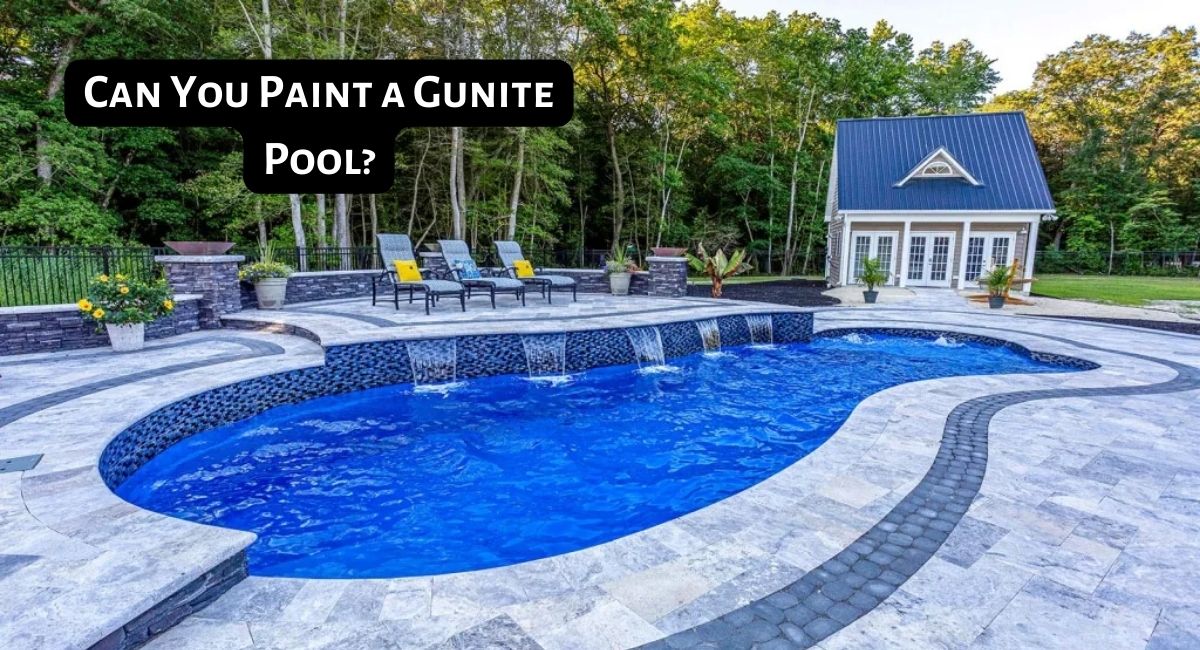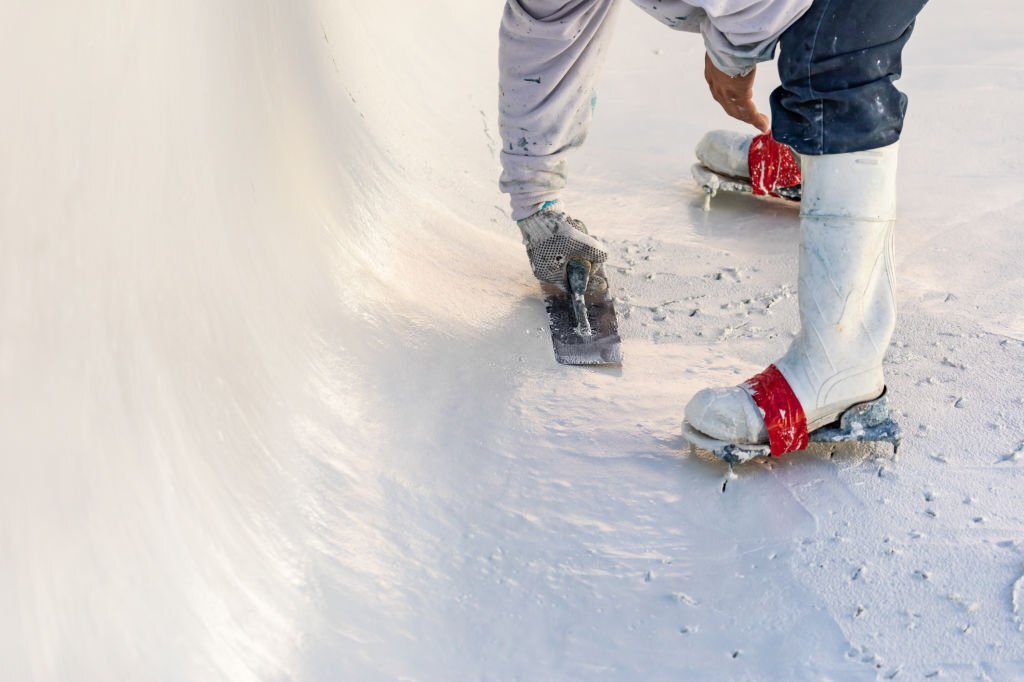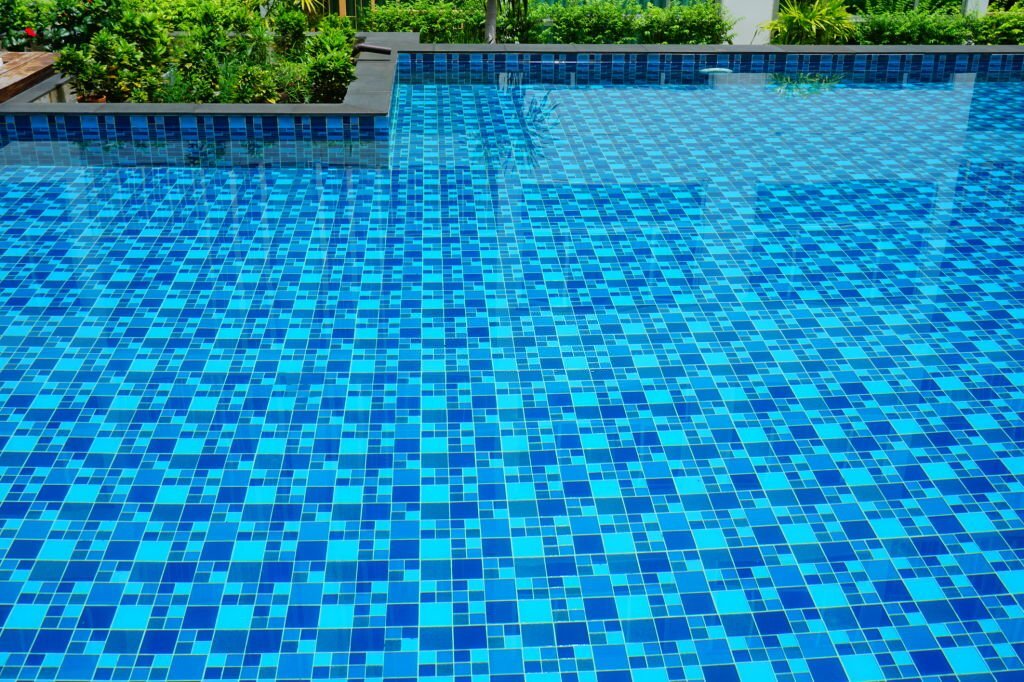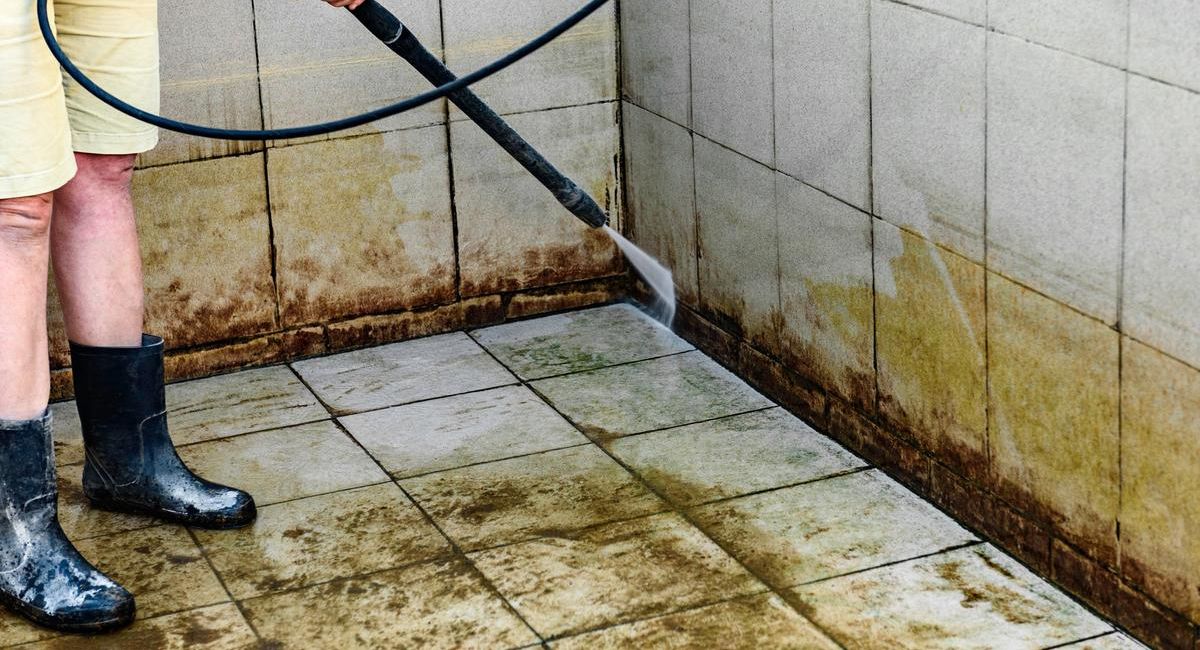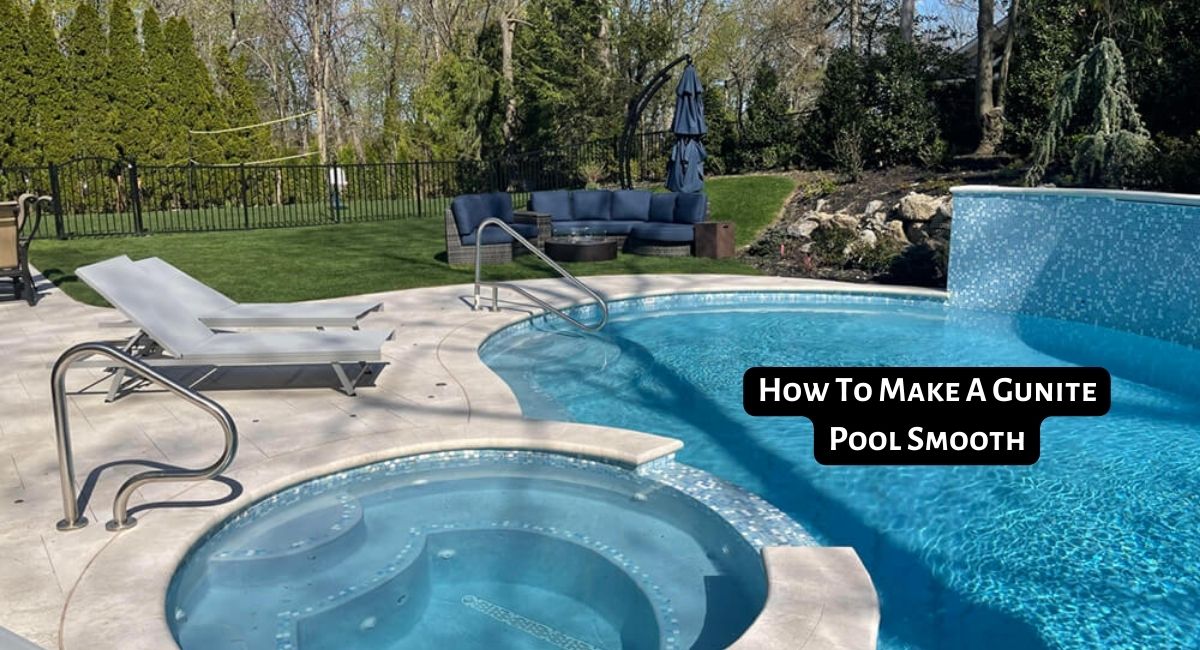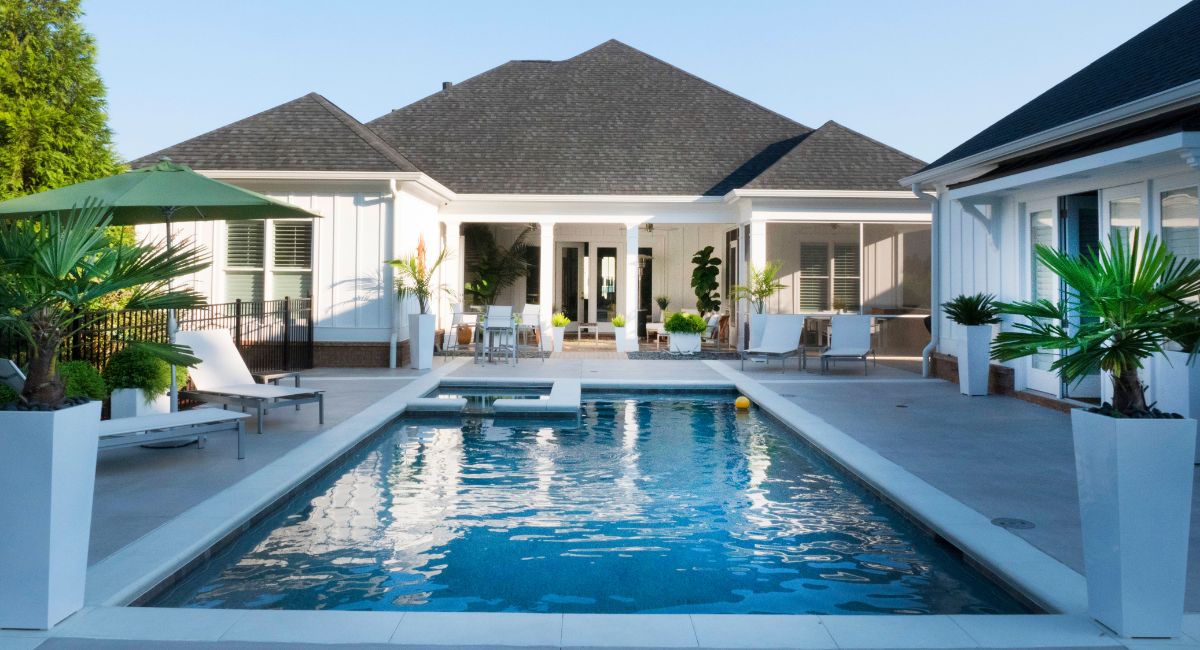When it comes to maintaining the allure and longevity of your gunite pool, few tasks are as transformative as a well-executed pool painting project. As a seasoned authority in pool care, we delve into the realm of gunite pool painting, an art that combines expertise with aesthetics to breathe new life into your aquatic oasis.
With years of hands-on experience and a deep understanding of the nuances involved, we’re here to unravel the mysteries and unveil the intricacies of painting a gunite pool. Dive into our comprehensive guide as we navigate the depths of this rejuvenating process, offering insights that echo the ripples of professional craftsmanship.
Table of Contents
- 1 Can You Paint a Gunite Pool
- 2 Pros and Cons of Painting a Gunite Pool
- 3 Types of Paint Suitable for Gunite Pools
- 4 Choosing the Ideal Paint for Your Gunite Pool
- 5 Preparing Your Pool for the Perfect Paint Job: A Step-by-Step Guide
- 6 Step-by-Step Guide to Painting Your Gunite Pool
- 7 Common Mistakes to Avoid
- 8 How Long Does a Newly Painted Pool Last
- 9 Common Problems With Painted Pools
- 10 Costs of Painting a Gunite Pool
- 11 Tips for Maintaining Pool Paint
- 12 Alternative Solutions to Painting
- 13 Conclusion
- 14 Frequently Asked Questions
Can You Paint a Gunite Pool
Absolutely! Painting a gunite pool is a viable and effective option to refresh its appearance and extend its lifespan. Gunite pools, known for their durability and flexibility, can benefit from a fresh coat of paint to revitalize their beauty.
However, painting a gunite pool requires careful preparation and the right materials to ensure a long-lasting and visually appealing result.
Below, we’ll dive into the details of painting a gunite pool, covering everything from preparation and paint selection to the step-by-step process.
Whether you’re a pool owner exploring maintenance options or a curious enthusiast eager to learn, we’ve got you covered with insights that make pool painting a smooth stroke of excellence.
Pros and Cons of Painting a Gunite Pool
Painting a gunite pool comes with its own set of advantages and disadvantages. Understanding these pros and cons can help you make an informed decision about whether painting is the right choice for your pool maintenance. Here’s a breakdown:
Pros of Painting a Gunite Pool
- Aesthetic Enhancement: Painting your pool can transform its appearance, giving it a fresh and rejuvenated look. You can choose from a variety of colors and finishes to match your desired aesthetic.
- Cost-Effective: Painting is often more budget-friendly compared to more extensive pool renovation options like resurfacing or rebuilding. It allows you to give your pool a facelift without the high costs associated with major renovations.
- Quick Revamp: Painting a pool is a relatively quick process, especially when compared to more time-consuming renovation projects. Depending on the size of your pool and weather conditions, you can enjoy your newly painted pool within a short period.
- Customization: Pool paint comes in various colors and finishes, offering you the opportunity to personalize your pool’s appearance according to your preferences.
- Extended Lifespan: The right paint can provide a protective barrier, extending the life of your pool’s surface by shielding it from UV rays, chemicals, and water exposure.
- DIY Option: Some pool owners choose to paint their pools themselves, making it a feasible DIY project for those with the necessary skills and time.
Cons of Painting a Gunite Pool
- Temporary Solution: While painting can improve the appearance, it’s not a permanent solution. Over time, the paint may fade, chip, or peel, necessitating periodic repainting.
- Maintenance: Painted surfaces require regular maintenance to ensure the paint’s longevity. Proper pool maintenance is essential to prevent the need for frequent repainting.
- Adhesion Challenges: Ensuring proper adhesion of the paint to the pool surface is crucial. Inadequate preparation can lead to peeling or chipping, requiring touch-ups or repainting.
- Limited Durability: Pool paint, while offering protection, is generally not as durable as some other pool finishes. Heavy pool use, exposure to harsh chemicals, and extreme weather conditions can impact the paint’s lifespan.
- Preparation Required: Properly preparing the pool surface before painting is crucial. This preparation process can be time-consuming and may require specialized tools and products.
- Professional Expertise: Achieving a high-quality, long-lasting paint job may require professional expertise. Professional painters are experienced in proper surface preparation and application techniques.
- Color Limitations: While pool paint offers color options, the range may be limited compared to other pool finishes.
Types of Paint Suitable for Gunite Pools
When it comes to painting your gunite pool, selecting the appropriate type of paint is essential to ensure not only a visually appealing result but also long-lasting protection against the demanding pool environment.
Gunite pools, being constructed from concrete, demand paints that can adhere effectively to their surface while enduring exposure to chemicals, UV rays, and the constant presence of water. Let’s delve into the various types of paints suitable for gunite pools, each with its unique attributes:
Epoxy Paint
Epoxy paint stands as a favored option for gunite pools that have never been painted before and possess a base of concrete, plaster, fiberglass, or gunite. Its popularity stems from its exceptional durability, granting it the ability to withstand the rigors of the pool environment. Resistant to chemicals, UV rays, and fading, epoxy paint ensures that your pool’s newly refreshed appearance remains intact for the long haul. This paint choice not only adds an attractive touch but also fortifies the pool’s surface against the elements.
| Pros | Cons |
|---|---|
| Durable and long-lasting | Can be more expensive than other options |
| Resistant to chemicals, UV rays, and fading | May require professional application |
| Suitable for various pool surfaces | Longer curing time |
Enamel Paint
Enamel paint offers a glossy finish that effortlessly complements the aesthetic of your gunite pool. Its water and chemical resistance, coupled with its ability to stand up against fading, make it a suitable choice for pools that have been previously painted and are in need of a fresh coat. Enamel paint’s enduring qualities revitalize the pool’s appearance while simultaneously enhancing its resilience to the challenges posed by pool chemicals and the sun’s rays.
| Pros | Cons |
|---|---|
| Provides a glossy finish | Not as durable as epoxy paint |
| Resistant to water, chemicals, and fading | May need more frequent touch-ups |
| Ideal for previously painted pools | Surface preparation is crucial for adhesion |
Acrylic Paint
Acrylic paint, known for its water-based composition, presents a user-friendly option for painting gunite pools. Its quick-drying nature facilitates ease of application, and although it may not match the durability of epoxy paint, it still offers commendable protection against chemicals and UV rays. Acrylic paint is a fitting choice for pools that have been previously painted and require a touch-up to restore their vibrancy and protection. While not as robust as epoxy, its convenience and affordability make it an appealing choice for many pool owners.
| Pros | Cons |
|---|---|
| Quick-drying and easy to apply | Less durable than epoxy paint |
| Water-based formula reduces odor and cleanup | Limited protection against harsh chemicals and UV rays |
| Suitable for DIY projects | May require more frequent repainting |
Rubber Paint (Chlorinated Rubber Paint)
Rubber paint, sometimes referred to as chlorinated rubber paint, emerges as another viable contender for gunite pool painting. Its notable resistance to pool chemicals ensures that the paint remains resilient even in the face of constant exposure. The finish achieved with rubber paint is smooth and glossy, contributing to the pool’s overall aesthetic. The adhesive properties of rubber paint promote a long-lasting bond with the pool surface, offering both protection and a visually pleasing result.
| Pros | Cons |
|---|---|
| Resistant to pool chemicals | Less common, may be harder to find |
| Smooth and glossy finish | May require more coats for optimal coverage |
| Excellent adhesion properties | Limited color options |
Water-Based Epoxy Paint
Combining the benefits of traditional epoxy paint with a water-based formula, water-based epoxy paint is a popular choice, particularly for DIY pool painting projects. It delivers similar durability and protection against the elements as traditional epoxy paint, while also boasting the advantages of easier cleanup and reduced solvent odor. Water-based epoxy paint offers an appealing balance between performance and user-friendliness.
| Pros | Cons |
|---|---|
| Similar durability to traditional epoxy paint | Not as robust as solvent-based epoxy paint |
| Easier cleanup and reduced solvent odor | Limited color options |
| Suitable for DIY projects | Surface preparation is important for adhesion |
Premium Acrylic Paint
For those seeking a high-quality option, premium acrylic paint presents itself as a top-tier choice. With excellent color retention and resistance to fading, it can be applied to various pool surfaces, including gunite. Its durability ensures lasting results, while its smooth finish adds an attractive touch to the pool’s appearance. Premium acrylic paint combines both aesthetics and resilience, making it a go-to choice for those looking to elevate their pool’s visual appeal.
| Pros | Cons |
|---|---|
| Excellent color retention and resistance to fading | Less durable than epoxy paint |
| Smooth and attractive finish | May need more frequent touch-ups |
| Suitable for various pool surfaces | Surface preparation is important for adhesion |
Choosing the Ideal Paint for Your Gunite Pool
Selecting the right paint for your gunite pool is a crucial decision that impacts both its appearance and durability. With a variety of paint types available, each offering distinct benefits and considerations, making an informed choice is essential. Here’s a step-by-step guide to help you navigate through the process and choose the best paint for your gunite pool:
- Assess Your Pool’s Condition: Begin by evaluating the current state of your gunite pool. Take note of any existing paint coatings, surface imperfections, and signs of wear and tear. This assessment will guide you towards the appropriate type of paint that suits your pool’s specific needs.
- Determine Your Priorities: Consider your priorities for the pool. Are you looking for long-lasting durability, a glossy finish, or quick DIY application? Understanding your preferences will help narrow down the options that align with your goals.
- Consider Pool History: Whether your pool has been previously painted or not matters. If it’s unpainted, epoxy paint is a robust choice. For repainting, enamel, acrylic, or water-based epoxy may be suitable based on your desired attributes.
- Evaluate Durability: If durability is a top concern, epoxy paint stands out for its long-lasting qualities. For moderate durability with user-friendliness, acrylic paint might be an option. Assess how heavily the pool is used to gauge the level of durability needed.
- Examine Aesthetic Preferences: The aesthetic you’re aiming for matters. Epoxy and enamel paints offer glossy finishes, while acrylic and premium acrylic paints provide a smoother appearance. Consider color options as well.
- Review Maintenance Expectations: Think about the maintenance you’re willing to undertake. Epoxy and rubber paints generally require less frequent repainting, while acrylic paints might need touch-ups more regularly.
- Budget Considerations: Your budget plays a role in your decision. Epoxy paint tends to be more expensive, while acrylic and water-based epoxy paints are often more budget-friendly options.
- Seek Professional Advice: If you’re unsure, consult pool professionals or paint experts. They can provide insights based on your pool’s specifics and your preferences.
- Read Product Information: When you’ve narrowed down your options, carefully read the product information provided by manufacturers. Look for details on adhesion, coverage, durability, and application guidelines.
- Test Samples: If possible, obtain small samples of the paints you’re considering and apply them to a inconspicuous area of the pool. This allows you to see how they adhere and how the colors look under your pool’s specific lighting conditions.
Preparing Your Pool for the Perfect Paint Job: A Step-by-Step Guide
Before you embark on the journey of transforming your gunite pool with a fresh coat of paint, meticulous preparation is essential to ensure a flawless and long-lasting result. Each step in the preparation process contributes to the quality of the final paint job. Let’s delve into the comprehensive process of preparing your pool for painting:
Draining the Pool: The first order of business is to drain the pool entirely. An empty pool is the canvas upon which you’ll work your painting magic. Ensure the pool is completely dry before moving forward, as moisture can interfere with paint adhesion and durability.
Cleaning the Pool Surface: Armed with a pool brush and an effective pool cleaner, meticulously clean the walls and floor of the pool. Rid the surfaces of dirt, debris, algae, and any other contaminants that might hinder paint adhesion. A clean canvas sets the stage for a successful paint application.
Repairing Cracks and Chips: Carefully inspect the pool surface for any cracks or chips that have developed over time. Address these imperfections by filling cracks with epoxy filler. For more significant repairs, use a patching compound to restore the surface to a level and smooth state. This step ensures a uniform and visually appealing result.
Sanding the Pool Surface: If your pool has been previously painted, it’s wise to sand the surface to eliminate any loose or flaking paint. Sanding not only creates a pristine canvas for the new paint but also enhances adhesion. The goal is to achieve a smooth and even surface free from imperfections.
Priming the Surface: Before the paint touches the pool, applying a high-quality primer is paramount. Opt for a primer specifically designed for swimming pools, as it enhances paint adhesion and strengthens the overall finish. The primer acts as the foundation for the paint, ensuring it adheres uniformly and provides lasting durability.
Ensuring Proper Ventilation and Protection: During the preparation process, ensure that the pool area is well-ventilated. Adequate ventilation helps with the drying of the primer and paint. Additionally, protect any surfaces you don’t want to be painted, such as tiles or coping, using masking tape and plastic sheets.
Timing and Weather Considerations: Plan your preparation and painting process based on weather conditions. Ideal conditions include dry, mild days without high humidity, rain, or extreme temperatures. These conditions facilitate proper drying and adhesion of the paint.
Equipping Yourself Properly: As you embark on this preparation journey, make sure you have the necessary safety equipment and tools at hand. Protective gear like gloves, goggles, and a respirator can safeguard you from potential fumes and debris.
Step-by-Step Guide to Painting Your Gunite Pool
Painting a gunite pool is a meticulous process that requires careful attention to detail to ensure a smooth, visually appealing, and long-lasting finish. Follow these step-by-step instructions to successfully paint your gunite pool:
Clean the Pool: Start by thoroughly cleaning the pool surface. Create a mixture of tri-sodium phosphate (TSP) and water as a cleaning solution. Use a scrub brush to scrub the entire pool, including the walls and floor, to remove dirt, algae, and other debris. After scrubbing, rinse the pool with clean water to ensure all cleaning solution is washed away.
Repair Any Cracks: Carefully inspect the pool surface for cracks, chips, or imperfections. Use a pool patch or underwater epoxy to repair any damage. Follow the instructions provided by the manufacturer for proper application and drying time. Allow the repairs to fully cure before moving on to the next step.
Sand the Pool Surface: Use a pool sander or a sanding block to lightly sand the entire pool surface. Sanding helps create a smooth and even surface for the new paint to adhere to. After sanding, clean the pool again to remove any dust or debris generated during the sanding process.
Prime the Surface: Apply a pool primer specifically designed for gunite surfaces. Follow the manufacturer’s instructions for application, ensuring that the primer is spread evenly. Allow the primer to dry completely before proceeding to the next step. Proper priming enhances paint adhesion and durability.
Apply the Paint: Choose a high-quality pool paint formulated for gunite surfaces. Begin by painting the edges and corners of the pool using a brush. Then, use a roller to apply the paint to the larger areas of the pool. Work in small sections to ensure even coverage. Apply the paint smoothly and evenly, avoiding drips or streaks.
Multiple Coats (If Needed): Depending on the paint and desired coverage, you might need to apply multiple coats. Allow the first coat to dry according to the manufacturer’s instructions before applying a second coat. Follow the same application process for each coat, ensuring consistency and evenness.
Cure and Fill the Pool: After the final coat of paint has been applied and has dried, it’s essential to allow the paint to cure fully. Refer to the manufacturer’s guidelines for the recommended curing time. Once the paint has cured, you can proceed to fill the pool with clean water. Be cautious not to disturb the paint while filling the pool.
Common Mistakes to Avoid
Avoiding common mistakes during the pool painting process is crucial to achieving a professional and long-lasting finish. Here are some common pitfalls to steer clear of:
- Insufficient Cleaning: Failing to thoroughly clean the pool surface before painting can lead to poor adhesion and an uneven finish. Make sure to remove all dirt, debris, and contaminants from the pool’s walls and floor using proper cleaning agents.
- Skipping Surface Repairs: Neglecting to address cracks, chips, or other imperfections in the pool surface before painting can result in an unsightly appearance and compromised durability. Repair any damage and allow sufficient time for the repairs to cure before painting.
- Inadequate Priming: Skipping the priming step or using the wrong type of primer can lead to paint adhesion issues and reduced durability. Always use a primer specifically designed for pool surfaces and follow the manufacturer’s instructions for proper application.
- Rushing the Application: Applying paint too quickly or without proper technique can lead to streaks, drips, and an uneven finish. Take your time, work in small sections, and apply the paint smoothly and evenly using appropriate tools.
- Incorrect Paint Choice: Choosing the wrong type of paint for your pool surface can result in premature peeling, fading, or poor adhesion. Select a high-quality paint that is specifically formulated for gunite pools and follow the manufacturer’s recommendations.
- Not Allowing Proper Drying and Curing: Rushing the drying and curing process can lead to paint damage and reduced longevity. Follow the manufacturer’s guidelines for drying and curing times before refilling the pool with water.
- Inadequate Ventilation: Failing to ensure proper ventilation during painting can result in fumes buildup and inadequate drying. Make sure the area is well-ventilated to ensure a safe and effective painting process.
- Ignoring Weather Conditions: Painting during unfavorable weather conditions, such as high humidity or rain, can affect the paint’s adhesion and drying. Choose a dry, mild day with appropriate temperatures for the best results.
- Not Using Protective Gear: Neglecting to use protective gear such as gloves, goggles, and a respirator can expose you to harmful chemicals and fumes during the painting process. Prioritize safety by using the appropriate protective equipment.
- Overlooking Manufacturer Instructions: Disregarding the manufacturer’s instructions for the paint, primer, and other materials can lead to suboptimal results. Always follow the guidelines provided to ensure proper application and longevity.
How Long Does a Newly Painted Pool Last
Once you have successfully painted your gunite pool, you may be curious to know how long it will last before needing another paint job. This is a difficult question to answer as there are several factors that can affect the longevity of your freshly painted pool.
UV exposure from sunlight and chemical interactions with chlorine or other pool chemicals can cause the paint on your gunite pool to fade quicker than expected. The quality of the materials used during painting also play an important role in determining how long the paint should last.
Quality paints usually offer better protection and durability when compared with cheaper versions. Additionally, proper surface preparation prior to painting is essential for ensuring maximum lifespan of the new finish.
Generally, a newly painted gunite pool should last anywhere between 3–5 years with proper maintenance and care. To ensure your paint job lasts as long as possible, it is important to regularly check the surface for any signs of damage or wear-and-tear.
This includes keeping an eye out for fading, peeling, cracking or blistering areas on the painted surface. If you notice any of these issues, it may be time to apply a fresh coat of paint.
Common Problems With Painted Pools
Here are some common problems that can occur with painted pools:
- Chipping/peeling paint: Pool paint can chip and peel over time due to factors like chemical exposure, sun damage, and normal wear and tear. This leaves bare spots of concrete exposed to water.
- Discoloration: Pool paint can become stained or discolored from algae growth, metal staining, calcium deposits, and other factors. This can give the pool an unappealing look.
- Loss of slip resistance: As pool paint wears down over time, the surface can become smoother and lose some of its slip resistance. This can make the pool floor and walls more slippery and potentially dangerous.
- Difficulty getting clean: When pool paint gets stained or etched, it can become harder to get the surface clean again. Proper pH balance and chemical treatments are important to avoid this.
- Blistering: Trapped moisture under the paint can cause it to blister. This usually indicates a problem with surface preparation prior to painting.
- Chalking: Some pool paints can become “chalky” over time, causing the finish to look faded and powdery. This is due to degradation of the binders in the paint.
- Crackling/alligatoring: Extensive cracking of the paint film resembling alligator skin. This is often due to incompatibility between layers of paint.
Proper surface prep, paint selection, application, and ongoing maintenance are key to avoiding many pool paint problems. Periodic re-painting may be needed over time as well. Consulting a pool professional is advisable.
Costs of Painting a Gunite Pool
Painting a Gunite pool may seem like a simple task, but there are many hidden costs to consider before doing so. Here’s a list of the most common and important costs:
- Preparation: Proper preparation is key to achieving the best results when painting a Gunite pool. The surface must be thoroughly cleaned and any rust or debris removed in order to ensure proper adhesion of paint. This can take several hours depending on the size of the pool and could require additional equipment such as pressure washers, sandblasting and grinding tools, as well as special chemical cleaners.
- Paint: Quality paint should always be used when painting a Gunite pool. Some paints are specifically made for Gunite pools and may cost more than regular paint. It is important to use the correct type of paint for your particular pool, as different types of paints are better suited for different surfaces and climates.
- Primer: Before painting a Gunite pool, primer must be used in order to ensure proper adhesion of the topcoat. Depending on the quality and type of primer used, this could add significantly to the overall cost of painting a Gunite pool.
- Equipment: Painting a Gunite pool requires certain specialized tools and equipment in order to achieve professional results. This includes things like scaffolding, ladders, rollers and brushes that may need to be rented or purchased if they aren’t already owned.
- Labor: Painting a Gunite pool is a time-consuming task, and therefore labor costs can be quite high depending on the size of the pool and complexity of the job. It is important to factor in these costs before undertaking such a project.
The cost to paint a gunite pool can vary depending on several factors such as the pool’s size and the type of paint used. On average, the cost can range from $1,000 to $4,500. Larger pools and those requiring more extensive surface preparation may be on the higher end of the price range.
Additionally, the type of paint used can impact the cost. Epoxy paint, for example, is known for its durability but may be more expensive compared to other options.
It’s important to note that these costs are estimates and can vary based on geographic location, the condition of the pool’s surface, and other factors. It is recommended to consult with professional pool painters to get accurate cost estimates for your specific pool.
Tips for Maintaining Pool Paint
Maintaining the paint on your Gunite pool is essential for keeping it looking its best. Here are a few tips to help keep your pool’s paint looking great:
- Clean the surface of the pool regularly to remove any dirt, debris, or algae that could cause damage to the paint over time. This is especially important if you live in an area with high humidity and lots of rain.
- Make sure you use a pool cleaning agent specifically designed for Gunite pools when cleaning your pool’s surfaces. Some common household cleaners can be damaging and should not be used on Gunite pools.
- Always use a primer before painting your gunite pool, as this will increase adhesion and longevity of the paint job.
- Use a high-quality, durable pool paint specifically designed for gunite pools to ensure that it will last longer and provide better protection against ultraviolet radiation and chlorine exposure.
- To extend the life of the paint, avoid direct contact with pool chemicals or other harsh substances and make sure to clean any spills immediately.
Alternative Solutions to Painting
If painting your gunite pool doesn’t seem like the best option for you, there are alternative solutions that you might consider to enhance the appearance and longevity of your pool. Here are some alternatives to pool painting:
Resurfacing: Resurfacing involves applying a new layer of pool finish over the existing gunite surface. Options for resurfacing include plaster, pebble, and aggregate finishes. Resurfacing not only improves the appearance of the pool but also provides a durable and long-lasting solution.
Replastering: Replastering involves removing the old plaster layer and applying a new one. It’s a popular choice for those who want a fresh and smooth surface for their pool. Replastering can address minor cracks and imperfections in the existing surface.
Tile Installation: Adding new tiles to the pool’s waterline or other areas can create an attractive visual impact. Pool tiles are available in various designs, colors, and materials, allowing for customization.
Pebble or Aggregate Finishes: Pebble or aggregate finishes consist of a mixture of pebbles, stones, and epoxy. These finishes offer durability, texture, and a natural appearance, enhancing both aesthetics and longevity.
Vinyl Liner Installation: For those who want a different look, consider installing a vinyl liner. Vinyl liners come in various patterns and can provide a smooth, clean appearance.
Fiber Reinforced Polymer (FRP) Coatings: FRP coatings are applied to the pool surface to provide an additional layer of protection and visual enhancement. They offer resistance to chemicals, UV rays, and water.
Microfinish or Quartz Finish: Microfinish or quartz finishes involve applying a mixture of quartz aggregate and cement over the existing pool surface. This finish provides texture, durability, and a unique appearance.
Pool Resurfacing Coatings: Specialty coatings designed for pool resurfacing can offer a cost-effective way to refresh the pool’s appearance. These coatings often include additives for better durability and performance.
Pool Liners for Above-Ground Pools: If you have an above-ground pool, using a pool liner can provide a protective layer and enhance the pool’s appearance.
Landscaping and Surroundings: Enhance the overall aesthetic appeal of your pool area by landscaping around it. Well-placed plants, shrubs, and hardscape elements can create a visually pleasing environment.
Conclusion
The process of painting a gunite pool can be a viable option for pool owners seeking to refresh the appearance of their pool surface. While it offers a cost-effective solution and a chance to customize the pool’s aesthetics, it’s crucial to approach the task with careful planning and the right materials.
Proper surface preparation, choice of paint specifically designed for gunite surfaces, and adherence to recommended application guidelines are essential to achieve a durable and visually appealing result.
However, it’s important to note that painting a gunite pool is not a permanent solution and will require maintenance and touch-ups over time. Ultimately, consulting with professionals and considering long-term maintenance factors will ensure the best outcome for those considering painting their gunite pool.
Frequently Asked Questions
1. Can you repaint a gunite pool?
Yes, you can repaint a gunite pool. Gunite is a type of concrete made from sand and cement that has been sprayed on with high-pressure water jets. It forms a durable surface that can withstand weathering and wear and tear, making it an ideal option for swimming pools. Painting your gunite pool will help protect the surface from corrosion and UV damage, as well as giving it a fresh look. Before painting your gunite pool, you’ll need to make sure the surface is clean and free of debris or algae. If there are any cracks in the surface, they should be patched up first before painting.
2. Can you change the color of a gunite pool?
Yes, you can change the color of a gunite pool. Gunite pools are made with a concrete and sand mixture that can be resurfaced to create different colors and designs. The process involves applying a special layer of paint over the existing surface, or pool plaster, which is then sealed for long-lasting protection and beauty. You can also use various pool finishes such as quartz and pebble aggregate to further customize the look of your gunite pool. With proper preparation and care, your gunite pool will keep its new color for years to come.
3. Is painting a pool a good idea?
Painting a pool can definitely be a good idea if you are looking to refresh the look of your pool or repair any surface damage. However, it is important to note that painting is typically only a temporary solution and may require regular maintenance in order for it to last long-term. Additionally, some types of pools cannot be painted due to their construction material, such as gunite pools. Therefore, it is best to do some research or consult with an expert before deciding on whether or not painting your pool is the right choice for you.
4. Does gunite fade?
Yes, gunite can fade over time due to exposure to the elements. Gunite pools should be sealed and re-painted every few years in order to maintain a high level of protection against fading and other damage. Additionally, regular cleaning with an appropriate pool cleaner will help preserve the color of the gunite surface. With proper maintenance, gunite pools can last for many years without needing to be repainted.
5. How to acid etch a gunite pool before paint?
Acid etching a gunite pool before applying paint is not a recommended method. Gunite pools are typically finished with a plaster layer, and acid etching can damage the plaster. It is recommended to consult a professional pool painter for proper surface preparation and painting techniques for gunite pools.
6. Should I paint or replaster my pool?
The choice between painting or replastering your pool depends on your budget, time, and desired longevity. Painting is more affordable and quicker but may need more frequent touch-ups. Replastering lasts longer but costs more initially. Consider your priorities and consult a pool professional for personalized advice.
